Our introduction to the jaw-dropping scenery of Peru’s Sacred Valley began long before we started our expedition along the Lares trek. Just getting to base camp entailed a drive up through winding mountain roads, passing a string of Inca ruins and rustic villages where we stopped for bread and other provisions in preparation for our four day hike deep into the wilderness of the Peruvian Andes on our way to Machu Picchu.
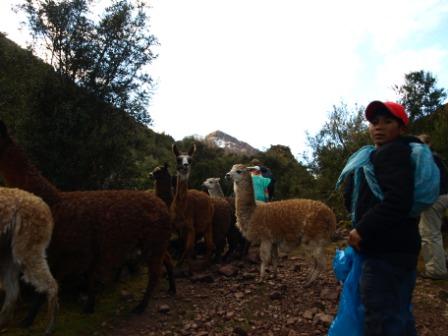
Passing a herd of llama on the first day. Photo by Matthew Barker, 2009
We’d only been hiking a few minutes before a steady drizzle started to fall, forcing us to stop and unpack our waterproofs from the mules. “Rain down here means snow up there,” said Luis, our guide, who pointed up the distant valley with a wry grin.
From the tiny settlement of Huaran we immediately began the steep, one thousand meter climb that would continue all day until we arrived at our first camp. Following a trail that hugged the edges of a fast-flowing river we entered a long, steep corridor of cloud forest leading up to the glacial peaks of Cancha Casa and Chicon that dominated the valley head.
Insisting that we keep a slow, steady pace, Luis began to share some of his vast knowledge of the area, pointing out the darting hummingbirds, explaining the symbiotic partnership between the bromeliads and their tree hosts and revealing the medicinal properties of the various plant life that lined our trail.
As we ascended the steep trail we could see the environment altering around us; flowering plants became less frequent, the trees became ever smaller until they resembled dwarfed stumps and the climate began to change, the wind picked up and a sharp chill entered the air.
But before we reached the tree-line itself it was time to break for some lunch. Meals during a Peru trekking tour are a logistical miracle, with a caravan of porters and mules racing ahead to set up kitchen and have a hot meal ready and waiting for the group’s arrival.
We replenished ourselves on a high energy lunch of steaming soup, sandwiches, fruit and cake before loading up again to continue the ascent until eventually emerging from the tree-line and out onto the rocky no-mans land between cloud forest and glacier, under the shadow of the snow-capped mountains ahead.
Trekking Tours:
We traversed this landscape for four steady hours until the trail led us into the minuscule village of Cancha Cancha, a settlement typical to this area of high Peruvian altiplano where llama and alpaca herding is the main occupation and braving the biting cold is a way of life.
The local children ran out to meet us as we entered the village, while the weary herds of animals showed more caution. Despite still being early, around 5pm, the sun had already disappeared behind the mountains and the evening cold had set in. It was here that our earlier shopping for all those famous Peruvian souvenirs; wooly hats, gloves and ponchos, proved its worth.
Before dinner was served, Luis pointed yet further up to the highest, snow-covered point of the mountain pass. “That’s where we’re heading tomorrow,” he declared. “As far and as high as you can see, in that direction!”
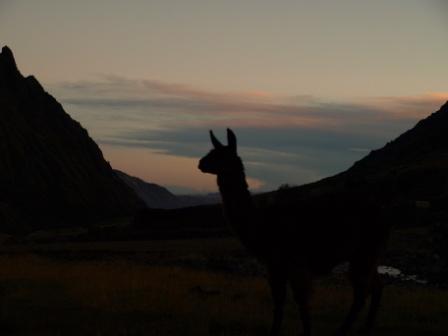 A llama-style sunset.
A llama-style sunset.
Photo by Matthew Barker, 2009
After an enormous meal of spicy soup, chicken, vegetables and mashed potatoes, our group sat in the dining tent, huddled for warmth with a cup of rum in hand, to listen to Luis’s descriptions of the folklore associated with the surrounding mountain ranges and later, explanations of the star constellations shining vividly overhead.
But the night was too cold for star gazing and by 9pm we were all in our tents, inside the sleeping bags and cozily wrapped up from the harsh elements of the altiplano.
We started the following day in luxury, having been woken at 5:30am with coffee and a bowl of hot water brought to our tent by our tireless porters. After filling up on breakfast and loading the mules we began the steady climb towards the first mountain pass of the trek.
As we rose towards the peaks we passed by a handful of youngsters, out keeping watch over herds of llamas and alpacas, before leaving all traces of civilization behind us. Up here there was nothing but Andean geese, a large native mountain bird called the Cara Cara, and oversized, stone-colored rabbits, the Viscacha, to keep us company.
As we hit the snow-line our trail took us past a series of large, natural caves in the mountain side. Luis explained that this spot is from where his spiritual ancestors were said to have originated, emerging from the cave carrying maize seeds, water and coca leaves, signifying the most important aspects of life in this region.
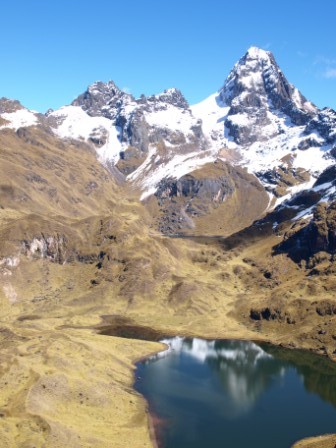
View from the first mountain pass. Photo by Matthew Barker 2009
Finally reaching the highest point of the Pachacutec pass at 4700m, we were rewarded with stunning views across two valley systems, while far below us lay a set of dazzling turquoise lakes. It was up here that Luis stopped to make a ceremonial offering to the mountain gods, the apus, lighting a small fire to burn incense, sweets, coca leaves and other important gifts which would help ensure our smooth passage through the mountains.
After skirting around the mountain peak we began the steady thousand meter descent back below the snow-line and towards our second camp, stopping again for a large lunch before arriving after a full 8 hours hiking in the small settlement of Quishuarani.
Quishuarani was a slightly larger settlement than the previous night’s camp and we were treated to such luxuries as cold beer and chocolate from the village store. As on the previous night, the local youngsters were fascinated with their strange-looking visitors and we spent a couple of hours handing out gifts of coloring books and pencils to the younger kids, while learning a few musical tricks from the older ones, expert players of an Andean ten-stringed instrument called the charango.
Our second camp was also blessed with a small shelter, constructed by the local reserve authority to encourage more visitors to the area, which offered us a warmer environment to eat dinner and share a few mugs of rum with our vivacious guide and a few local villagers.
“Right! I’m going to teach you one of our Andean games!” Luis roared across the table, signaling the start of a long, happy night of dice games and rum drinking that lasted into the small hours.
After our late night we emerged the following morning with startlingly clear heads – perhaps a benefit of the fresh mountain air. “Everyone needs to fill up with a good breakfast,” Luis instructed, “and take plenty of water too. We’ve got a big day ahead of us.”
It was good advice: from Quishuarani we made the most demanding hike of the trip, tackling an incredibly steep incline that took us up to Hullquicasa which, at 4400 m above sea level, was the second big mountain pass of our trek.
We were back above the snow line here, although the sun and the sheer physical exertion had everyone sweating buckets. In fact, we were concentrating so hard on getting up the mountainside, we almost missed the astonishing landscape we’d just walked into.
“Now look behind you,” Luis coolly suggested as we clambered, spluttering and wheezing, to the highest point of the pass. The view was almost unbelievable, as though we’d walked into a painting: the mountain fell away from us into a long, wide and grassy valley, dotted with brilliant blue lakes that reflected the skies like shimmering mirrors. Semi-wild horses, ancient stone buildings and small herds of llamas dotted the foreground, while in the distance was a never ending range of jagged mountains and snow-topped peaks.
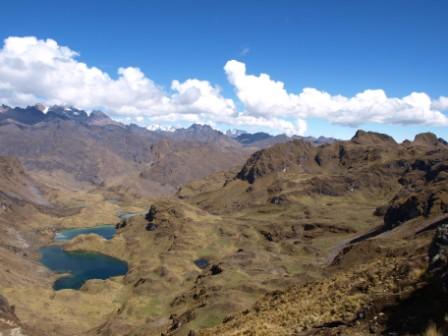 View from the second mountain pass of the Lares Trek, Peru.
View from the second mountain pass of the Lares Trek, Peru.
Photo by Matthew Barker, 2009
This was a perfect spot to catch our breath and replenish ourselves on some high-energy snacks. But our smug self-congratulations for having made it up such an impossible climb were shattered by the arrival of an elderly lady, a local to the area, who was virtually running up the trail, a baby wrapped up on her back and a toddler pattering along beside her.
“Napaykullayki!” she called over, the regional Quechua greeting, shooting us a toothy grin as she raced past and down the other side, quickly becoming a small, colorful dot in the landscape.
Shamed into action, we clambered back onto our feet and began the descent down into the next valley. The trail passed dozens of small, perfectly calm lagoons and a swift river that eventually turned into a sequence of increasingly impressive waterfalls. Along the sides of the valleys were wide screes of boulders and rocks that had fallen from the mountain sides and now provided an ideal home for bounding families of the Viscacha rabbits who were entirely oblivious to us as we walked by.
Stopping for a short break next to one of these lagoons, the peace was disturbed by a suddenly animated Luis, breaking his cool for a rare, excited moment to point out the enormous condor circling above our heads.
The condor, the largest flying bird in the Americas, is a creature of immense spiritual and symbolic importance to the indigenous people of the Andes, as Luis’ reaction made clear. “That is a sign of real luck, my friends!” He beamed at us. “The condor isn’t so common in this range, but the mountains have certainly blessed us today!”
After stopping for lunch at the river-side village of Cuncani, we continued along the downward trail, following the river towards the Lares valley itself. During the wet season, this onward journey is usually split across two days, but thanks to the dry conditions we were able to continue walking for much longer.
After Cuncani the trail returned us to the tree-line and re-entered the more humid and milder climate and ecosystem of the Andean tropical forest. The path snaked through farmland and rustic agricultural settlements before dropping again, into the more settled and tamed environment of the Lares valley.
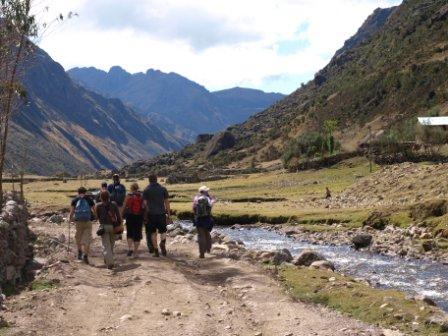 Entering the Lares Valley, Peru.
Entering the Lares Valley, Peru.
Photo by Matthew Barker, 2009
Before long, the river had become a gushing torrent, fueled by the glacial waters running through the valley which itself had become increasingly lush, the trees grew taller, the undergrowth thicker, and the sounds of birdsong returned to the breeze.
Eventually, rounding a corner along the valley’s edge we were presented with the most welcome sight in days: our camp, already set up by our outstanding team of porters, situated directly next to the series of therapeutic hot springs that make the village of Lares famous.
This was luxury in the true sense of the word and as we stripped out of our mud-clad trekking gear and into the hot showers and pools to rest our weary muscles, it was hard to suppress our grins of absolute contentment.
Having completed an extra stretch of hiking the following day, our final day on the trek was a much more relaxed affair, starting with another dip in the springs before making the gentle walk away from Lares along farmland towards some nearby Inca ruins.
The easy trail was a good chance to rest our legs after the demands of the previous few days, as well as catch a glimpse of rural life in the Andean pueblos that we were passing. Occasionally we came across snapshots of times gone by, a paved trail created during the days of the Inca, or a cliff-side cemetery where the bodies of nobles were buried, along with rich offerings to the same mountain gods to which Luis had prayed.
The trail eventually led us to a small village which marked the end of our trek. Here we reacquainted ourselves with the modern world (crossing a road was a novelty, the sound of a car was startling,) unloaded the mules and gave our deep and sincere thanks, along with a healthy tip, to the porters who had worked so hard to make our experience such a memorable one.
Luis stayed with us for the road journey back to Ollantaytambo, a town which had seemed so tiny five days ago, but which felt like a buzzing metropolis when we returned. Here, all that was left was to shake Luis’ hand, thank him for being such an outstanding guide, and catch the train for our much anticipated Machu Picchu tour, the final piece and pinnacle of our Sacred Valley adventure.
While planning a trip to Peru, consider that operators for Peru tours and treks abound, but the quality and levels of service can be highly inconsistent. For the best standards in safety and comfort, do your research before you leave and check the online reviews for international providers of Peru vacation packages.
The Inca Trail is by far the most popular route, but the Lares trek is just one of many less-busy alternatives, including the long and spectacular Salkantay trek, or the much shorter Chacan trek.
When packing for your Peru trek, make sure to bring the following essentials:
– Waterproofs, both for yourself and for your daypack.
– Educational or healthy gifts for the kids you’re bound to meet on the way.
– Suitable water bottles or canteens for the drinking water that is usually provided.
– A head torch to keep things well lit up and your hands free.
– Plenty of good quality, warm layers that you can add and remove as the temperatures swing from very warm to freezing cold.
– A good quality, all-seasons sleeping bag and a sleeping bag liner, both of which can be rented in Cusco.
Plan your own tour to Machu Picchu and trekking adventure. Call and chat with one of our expert travel advisors now!


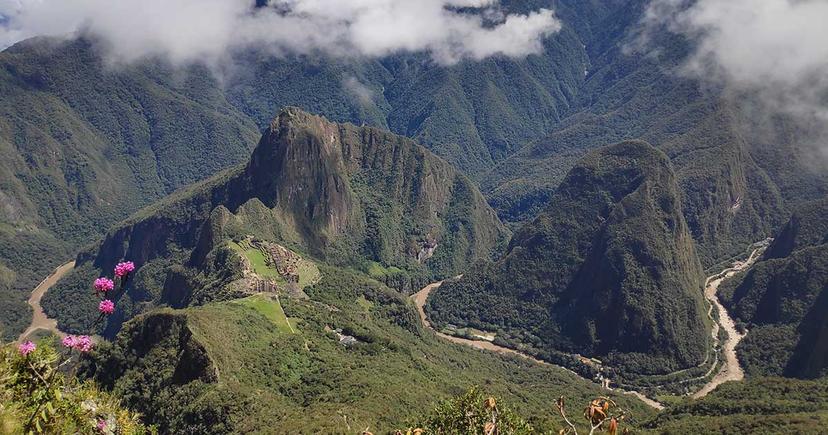
Email: [email protected]
Sign up to receive our newsletter for great articles, stunning photos, and special deals.